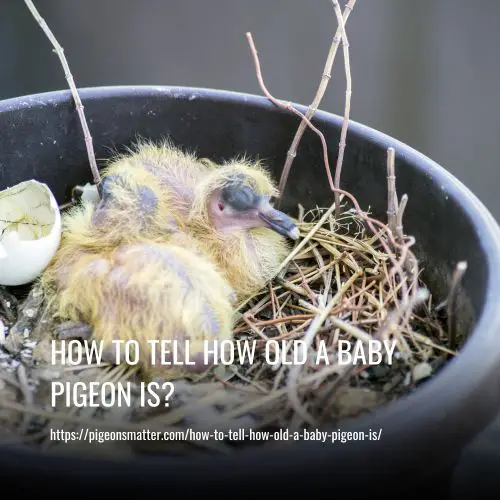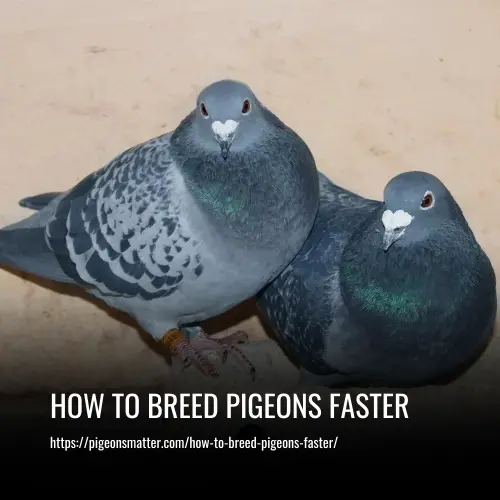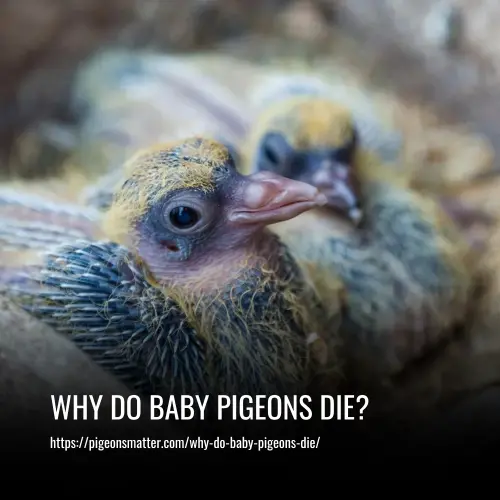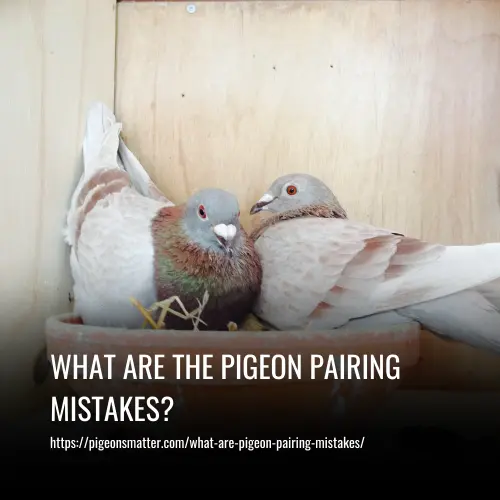You can tell how old a baby pigeon is by looking at its eyes. If the eyes are blue, the pigeon is less than two weeks old. If the eyes are turning brown, the pigeon is between two and four weeks old. If the eyes are brown and there are feathers on the back of the head, the pigeon is more than four weeks old. You can also look at the size of the baby pigeon and check if it can fly. A newborn pigeon will be small with few feathers, while an older pigeon will have larger size and more developed feathers.

Is There a Way to Find the Age of the Pigeon
Determining the exact age of a pigeon is a challenge as there is no definite answer. Researchers have been unsuccessful in determining the age of these birds. However, there are certain factors that can help in figuring out the age of these birds. For example, the development of feathers, lack of patterns, changing tail feather colors, and white patches on feathers might indicate the age of the pigeon.
The only way to precisely know the age of a pigeon is by keeping track of it from the day it is born. It is impossible to know the age of wild pigeons as they grow and mature on their own and there is no way to keep track of it. By studying the pigeon’s activity levels, one might be able to establish age.
Another way to determine the maturity of the pigeon is by observing its waddle. The larger and crustier the waddle, the older the pigeon is. It is said that an increase in size occurs every three years in an older pigeon. The size and weight of adult pigeons can be misleading as they appear larger than domesticated birds.
Young pigeon chicks have a sky-grey color, with a slightly pink breast, and have no neck markings until they are six months old. Around this age, they begin to develop white patches on both sides of their necks and fully-formed bands around eight to nine months of age.
Wild pigeons can be recognized by the color of their beaks. Young pigeons have dark grey beaks, while adults have a slightly pale yellow beaks with a white lining. Although determining the age of a pigeon may seem impossible, careful observation of the birds’ feathers, eyes, size, and weight can provide insights into their maturity level.
What Does a Baby Pigeon Look Like
A baby pigeon, also known as a squab, has minimal to patchy yellow feathers, which will eventually grow into fully-formed bands around 8 to 9 months of age. They have pink or darkish skin and proportionally larger beaks, wings, and feet. The beak is mainly pinkish, and the feet have a slate-grey color.
Hatchlings are altricial and require parental care for feeding and care. They are born with their eyes closed and lay prone. Weekly, they open their bills and lift their heads. The eyes of a baby pigeon usually open between 4 and 5 days old.
While it is rare to spot baby pigeons in this state unless domesticated, seeing pigeons during their juvenile stage is more common. During this stage, they have fully-formed features similar to adults, such as their downy feathers, beaks, membrane, nostrils, eyes, and wings.
How Long Before Pigeons are Full-Grown
Pigeons undergo rapid growth and development, which typically takes around six months to reach full maturity. During this time, physical changes occur, such as feather development and changes in size and coloration.
In addition to physical development, behavioral changes also indicate maturity; for instance, male pigeons will engage in courtship behavior and show territorial aggression.
To identify the gender of mature pigeons, males possess a more pronounced forehead and neck bulge, while females have a flatter shape with a smaller bulge.
In the wild, the availability of food can affect the rate of development, while domestic pigeons have a more consistent supply and may reach maturity earlier.
How Many Years Do Pigeons Live
Pigeons typically live for 10-15 years on average, with the oldest one recorded living for 33 years. However, their lifespan may vary depending on several factors like food availability, habitat, predators, and illness.
Pigeons in captivity tend to live longer, up to 15 or more years, than those in the wild. This difference in lifespan is because domesticated pigeons have consistent access to food and face fewer predators than their wild counterparts.
In the wild, these birds may succumb to disease, predators, and lack of food and water. Apart from that, competition for resources among the same species of pigeons and other bird species could affect their survival.
Different types of pigeons have their physical attributes and different behaviors that may influence their lifespan. Factors like their size, breeding patterns, and their natural habitats may have significant effects on their overall health and lifespan.
How Old are Fledgling Pigeons
Fledgling pigeons typically begin to leave the nest, or fledge, at around 4 to 5 weeks old. This process marks their transition from chick to independent bird, as they grow their adult feathers and develop coordination skills necessary for life outside the nest.
As pigeons continue to develop, their feather molt patterns change. While young birds have a mix of downy and adult feathers, they will eventually lose their downy feathers and replace them entirely with adult feathers.
The average fledgling pigeon is around 6-7 weeks old. At this stage, they have grown considerably in size and weight, and their adult feathers have fully developed.
Proper identification of fledgling pigeons is crucial to their survival, as they rely on parental care until they can sustain themselves. By understanding milestones in their development, we can provide better care and support for these young birds as they take their first steps in the world.
When Do Baby Pigeons Start to Fly
Baby pigeons, or squabs, typically start flying between 6-8 weeks of age. By this time, they have grown considerably in size and weight and their feathers have fully developed.
However, it’s important to note that although they have developed the ability to fly, they aren’t quite as skilled at flying as adult pigeons until around 3-4 months of age.
During the first few weeks of their life, baby pigeons are mainly stationary, as their eyes are still closed and feathers haven’t developed. By 2-3 weeks of age, their eyes will gradually open and they will start to explore their surroundings by hopping around.
Around 3-4 weeks old, baby pigeons will begin to take their first flight, hopping/flying a few inches at a time. As they continue to practice and develop their flying skills, they will gradually become more confident and skilled flyers.
So if you come across a young pigeon on the ground, there’s no need to worry! They may just be taking their time learning how to fly and exploring their surroundings.
Why Don’t You See Baby Pigeons
Baby pigeons are rarely seen because they spend a longer time in the nest compared to other birds, usually around 30 days. When they are ready to leave the nest, they already have plumage that closely resembles adult pigeons, making them difficult to distinguish.
Additionally, pigeons tend to nest in inaccessible areas such as church towers, under bridges, chimneys, and abandoned buildings, which are often out of sight for humans. This behavior stems from their instinct to nest in secure locations, similar to their ancestors, the rock doves, which nested on cliff edges to protect their nests from predators.
FAQs
The age of a baby pigeon can be easily determined by examining its eyes. Blue eyes indicate that the pigeon is less than two weeks old, while brown eyes suggest the pigeon is between two weeks to two months old. If the eyes are yellow or green, then it indicates the pigeon is older than two months. Examining the eyes is the most reliable method of determining the age of baby pigeons.
A baby pigeon can feed on its own when it reaches 4 to 6 weeks of age. At that time, it will have most of its feathers and ability to fly short distances. Although the parents will still continue to feed the baby pigeon, it will also start exploring and consuming food on its own.
To ensure a healthy diet for a 3 week old pigeon, provide a specialized formula for pigeons as their primary food. In addition to this, a small amount of cooked rice, oatmeal or baby cereal can also be given. Keep fresh water readily available for the bird at all times.
Baby pigeons are usually capable of flying within a span of 6-8 weeks after hatching. However, if the pigeon is weak or unfavorable weather conditions persist, it may take a little longer for them to fly.
To determine a baby pigeon’s age, observe its feathers. If the pigeon has all of its feathers, the bird is at least 6 weeks old. This is the easiest way to identify the age of a baby pigeon.
Baby pigeons typically weigh around 15 grams when they are newly hatched. As they grow, they can gain about 4 to 8 grams per day, reaching a weight of around 270 to 350 grams by the time they are 30 days old.
Conclusion
This article provides a thorough guide to determining a baby pigeon’s age. By observing their physical characteristics such as the presence of downy feathers, open or closed eyes, and ability to perch, one can estimate their age within a certain range. Additionally, understanding the stages of development and behavior during the juvenile stage can also provide insight into their age.
Accurately determining a baby pigeon’s age is crucial for their care and feeding, ensuring they receive the appropriate food and care for their stage of development. By following the tips outlined in this article, caregivers can ensure the healthy growth and development of their baby pigeon.


